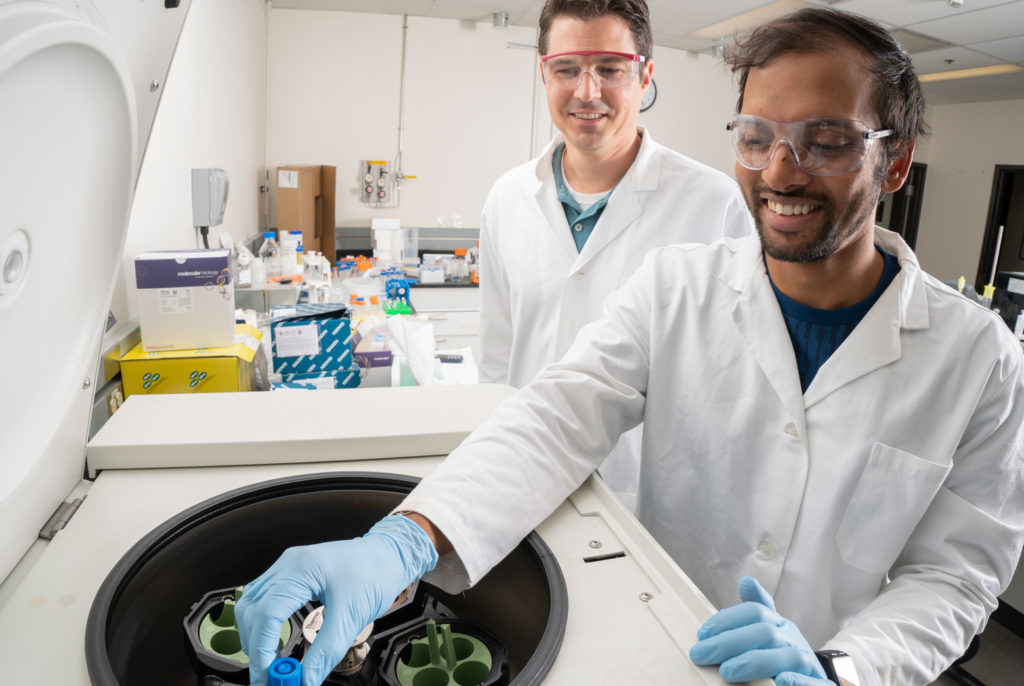
Cancer: Faster screening to hit “undruggable” targets
Coiled proteins could stop cancer and other diseases from overriding signals within cells.

Coiled proteins could stop cancer and other diseases from overriding signals within cells.

Medicines made from coiled protein fragments could provide a new handle on hard-to-treat diseases like cancer, but they are difficult to design. A new technique, developed at the University of Michigan, could change that. It can harness bacteria to produce billions of different drug candidates that won’t fall apart quickly inside the body.
Some advanced cancer medications target cancer cells with immune markers that latch onto the outsides of the cancer cells, for instance. But these immune markers are large, operating between cells rather than inside them. To disrupt cancer cells from within, the medicine must be small enough to get into the cell. However, ordinary small-molecule medications can’t hit messenger proteins with smooth surfaces. A new type of medication is needed.
“It’s a Goldilocks principle,” explained Greg Thurber, an associate professor of chemical engineering, who led the work. “The drug has to be small enough to get into cells but large enough to grab onto proteins inside cells that don’t interact with ordinary small-molecule drugs.”
It’s a Goldilocks principle. The drug has to be small enough to get into cells but large enough to grab onto proteins that don’t have small binding pockets.”
Greg Thurber, associate professor of chemical engineering
Protein fragments, known as peptides, could fill this gap. They are small enough to slip inside cells but complex enough to bind with smooth proteins.
One example of an “undruggable” target is MDM2, a protein that sidelines another protein known as the “guardian of the genome.” This guardian, known as p53, stops cell division when genetic mutations arise, buying time for DNA repair. It can also initiate self-destruction if the genome is in bad shape. It is our front-line cancer defense.
However, cancer cells fight back by overproducing p53’s inhibitor, MDM2, which binds to p53 and prevents it from doing its job. But if something intercepts the MDM2 before it ties up the p53, the cancer cells might do everyone a favor and self-destruct.
This is just one of therapies that might be possible with peptides. And the U-M team has developed a way to design them. The key innovation is how Thurber’s team stabilized the peptides, which are prone to falling apart in complex environments like the human body.
“The peptide is like a Slinky, but you tie together links so it doesn’t stretch out. That’s what we do chemically,” said Thurber.
The tie enables different drug candidate peptides to be built with bacteria as opposed to using simpler organisms, such as phages—which are essentially viruses for bacteria. Phages make only five peptides at a time, rather than the 10,000 or so that bacteria can make. The peptides on bacteria are so plentiful that researchers can see how well they work right on the bacterium. In contrast, the phage method requires additional labor-intensive steps to find out how well peptides bind and whether they fall apart easily.
Thurber’s team used E. coli bacteria to build hundreds of millions of peptides with random variations, looking for the one that was best at binding MDM2. The instructions for the peptides were written into rings of genetic code that the researchers slipped into the bacteria, causing the bacteria to produce the peptides on their cell membranes.
The ties were made from synthetic molecules that the bacteria swapped in for a peptide building block that they couldn’t produce. Unlike earlier ties incorporated into phage-built peptides, the synthetic molecules won’t bind to other molecules in and around the bacteria. It’s an example of “click chemistry,” tidy enclaves in the messy world of organic chemistry in which molecules reliably react together but are otherwise inert.
“The problem was that the reaction to tie the coils together killed the bacteria,” said Tejas Navaratna, a PhD student in chemical engineering at U-M and first author on the paper in the Journal of the American Chemical Society. “We spent months trying to optimize the reaction so that the bacteria survived, but we eventually realized we’d have to extract the DNA that coded our best peptides and add it to fresh, live bacteria.”
Each bacterium produced a different peptide, enabling the team to test hundreds of millions of different designs. To find out whether the peptides worked, the researchers mixed MDM2—attached to fluorescent molecules—in with the bacteria. The cells that lit up were producing a potentially useful drug.
While this technique is especially attractive for finding new cancer drugs, coiled peptides are under exploration for managing diabetes and HIV. The main challenge is getting the peptides into cells, which is a problem that Thurber’s team is currently pursuing.
The paper describing this work is titled, “Directed Evolution Using Stabilized Bacterial Peptide Display.” The study was funded by the National Science Foundation and the National Institutes of Health.